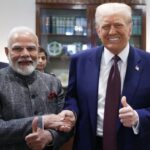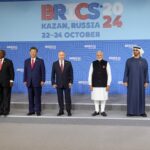Calling it a “discounted reciprocal tariff,” President Donald Trump, on April 2, 2025, in his Liberation Day Address from the Rose Garden at the White House, announced sweeping tariffs on all incoming goods from countries worldwide, including South Asian nations.
A baseline 10 percent tariff on all imports will be effective from 12:01 a.m. EDT on April 5th, while higher, country-specific tariffs will be implemented from 12:01 a.m. EDT on April 9th.
Highlighting that the United States charges only a 2.4 percent tariff on motorcycles, President Trump pointed out that other countries impose significantly higher tariffs. He noted that India levies a 70 percent tariff on American motorcycle imports, prompting his administration to impose a 26 percent tariff on Indian goods.
“India, very, very tough. The Prime Minister just left. He’s a great friend of mine, but I said, you’re a friend of mine, but you’re not treating us right. They charge us 52 percent… we charge them almost nothing for years and years and decades,” President Trump stated.

Trump also addressed tariffs imposed by other South Asian nations, stating that Bangladesh imposes a 74 percent tariff, Pakistan 58 percent, and Sri Lanka 88 percent on U.S. imports. In response, the U.S. will impose tariffs of 37 percent on Bangladesh, 29 percent on Pakistan, 44 percent on Sri Lanka, and 10 percent each on Bhutan and Afghanistan.
“India imposes their own uniquely burdensome and/or duplicative testing and certification requirements in sectors such as chemicals, telecom products, and medical devices that make it difficult or costly for American companies to sell their products in India. If these barriers were removed, it is estimated that U.S. exports would increase by at least $5.3 billion annually,” noted a White House Fact Sheet released on April 2nd.
The Fact Sheet detailed tariff disparities and non-tariff barriers imposed by various nations, including India. It noted that while the U.S. imposes a zero percent tariff on networking switches and routers, India levies a 10-20 percent tariff. For rice in the husk, the U.S. charges 2.7 percent, whereas India imposes an 80 percent tariff. Similarly, while apples enter the U.S. duty-free, India applies a 50 percent tariff.
Terming it as Liberation Day, the President said, “April 2, 2025, will forever be remembered as the day American industry was reborn, the day America’s destiny was reclaimed, and the day that we began to make America wealthy again.”
He characterized the tariffs as “common sense, reciprocal tariffs,” describing them as “kind reciprocal,” but “not full reciprocal.”

“My answer is very simple. If you want your tariff rate to be zero, then you build your product right here in America, because there is no tariff if you build your plant, your product in America,” Trump stated.
He anticipated that his announcement would prompt calls from world leaders seeking exemptions. His response to them, he said, would be: “terminate your own tariffs, drop your barriers. Don’t manipulate your currencies.”
Trump criticized decades of trade policies that, in his view, disadvantaged America, asserting, “For decades, America has been looted, pillaged, raped, and plundered by nations near and far, both friend and foe alike. Foreign cheaters have ransacked our factories, and foreign scavengers have torn apart our once beautiful American dream.”
Calling the tariffs “our Declaration of economic independence,” he emphasized that hardworking Americans had long been sidelined while other nations grew wealthy at America’s expense. He asserted that the new tariffs would generate trillions of dollars to reduce taxes and pay down the national debt.
Trump argued that for decades, the U.S. lowered its trade barriers while other countries imposed high tariffs and non-monetary barriers, manipulated their currency, subsidized exports, and stole American intellectual property.
Referring to North American Free Trade Agreement (NAFTA), US-Mexico-Canada, President Trump asserted that since its inception, the U.S. had lost 90,000 factories and 5 million manufacturing jobs, accumulated trade deficits of $19 trillion, and seen foreign nations acquire $26 trillion worth of American assets.
“But we’re getting smart nearly a century later, in the face of unrelenting economic warfare, the United States can no longer continue with a policy of unilateral economic surrender. We cannot pay the deficits of Canada, Mexico and so many other countries,” he said adding that America has borne the burdens of others without reciprocal treatment.
“And today, we’re standing up for the American workers and we are finally putting America first,” he added.






